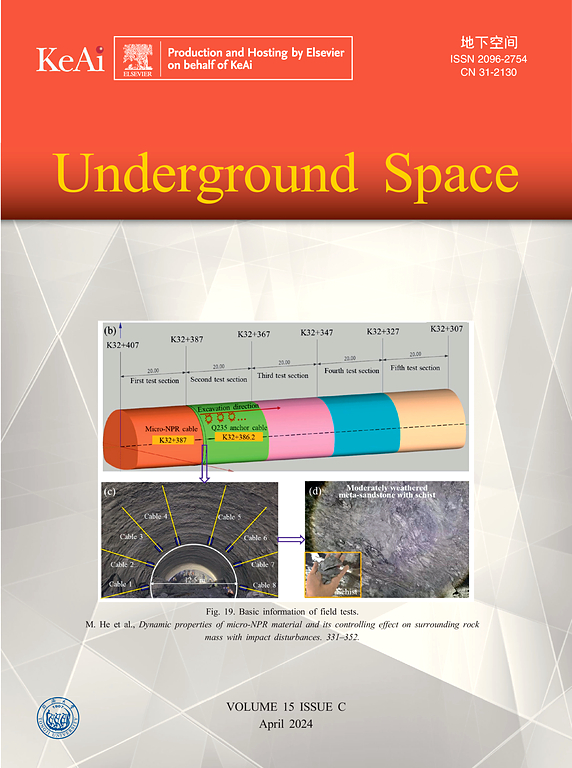深埋盾构隧道土拱效应的试验与数值研究
IF 8.3
1区 工程技术
Q1 ENGINEERING, CIVIL
引用次数: 0
摘要
深埋盾构隧道开挖引起的土拱效应对地应力和位移影响较大。因此,揭示土拱效应的演化机制是准确预测深埋条件下隧道荷载的前提,而深埋条件下的土拱效应尚未得到充分认识。通过3次模型试验和8次数值模拟,分析了土拱演化过程中的应力场、位移场和应变场。试验和数值结果表明,地面反力曲线呈现先线性减小后逐渐减小的两阶段发展过程。由于松动土压力理论忽略了土拱效应的演化过程,与理论隧道荷载相比,实测值和数值均较大。土拱高度随应力水平的增加而减小,分别为1.75D(模型隧道初始直径)、1.65D和1.61D,这是高应力条件下土拱效应滞后演化的结果。剪切带的形成受土体应力依赖性剪胀的影响。在低应力水平下,剪切带垂直向上发育。相反,在较高的应力水平下,剪切带向侧向倾斜。本文章由计算机程序翻译,如有差异,请以英文原文为准。
Experimental and numerical study on the soil arching effect caused by deep-buried shield tunneling
The soil arching effect induced by deep-buried shield tunneling strongly influenced the ground stress and displacement. Therefore, revealing the evolution mechanism of the soil arching effect is a prerequisite for accurately predicting the tunnel load, which has not been understood in deep-buried conditions. Three model tests and eight numerical simulations were carried out to enhance the understanding of the soil arching evolution, in which the stress field, displacement field, and strain field were analysed. The experimental and numerical results indicated that the ground reaction curve presented a two-stage development process of an initially linear decrease followed by a gradual decrease. Compared with the theoretical tunnel loads, the measured and numerical values are relatively larger due to the loosening earth pressure theory ignoring the evolution process of the soil arching effect. The soil arching height decreases with the increase in stress level, measuring 1.75D (the initial diameter of the model tunnel), 1.65D, and 1.61D, respectively, which results from the lagging evolution of the soil arching effect under high-stress conditions. The formation of the shear band was affected by the stress-dependent dilatancy of the soil. At low stress levels, the shear band develops vertically upward. In contrast, at higher stress levels, the shear bands tilt towards the lateral side.
求助全文
通过发布文献求助,成功后即可免费获取论文全文。
去求助
来源期刊

Underground Space
ENGINEERING, CIVIL-
CiteScore
10.20
自引率
14.10%
发文量
71
审稿时长
63 days
期刊介绍:
Underground Space is an open access international journal without article processing charges (APC) committed to serving as a scientific forum for researchers and practitioners in the field of underground engineering. The journal welcomes manuscripts that deal with original theories, methods, technologies, and important applications throughout the life-cycle of underground projects, including planning, design, operation and maintenance, disaster prevention, and demolition. The journal is particularly interested in manuscripts related to the latest development of smart underground engineering from the perspectives of resilience, resources saving, environmental friendliness, humanity, and artificial intelligence. The manuscripts are expected to have significant innovation and potential impact in the field of underground engineering, and should have clear association with or application in underground projects.
 求助内容:
求助内容: 应助结果提醒方式:
应助结果提醒方式:


